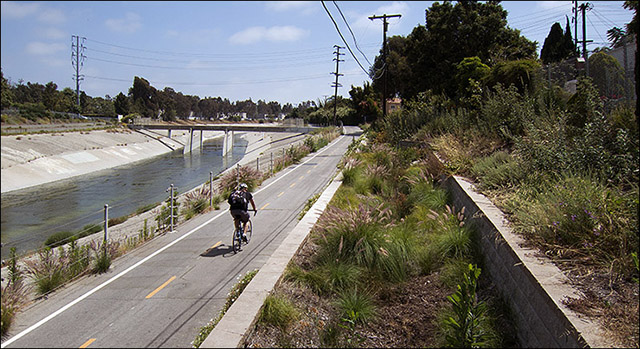[Previous entry: "Apple Drives Us Crazy Sometimes"] [Next entry: "Waiting in the Wings: Merino T-shirts!"]
06/17/2012: "Up the Creek"
Yesterday Gina and I indulged in an odd bit of hybrid outing....I'd wanted to take her by Primo Passo, a new coffeehouse in Santa Monica on snooty Montana Avenue but not at all a snooty place itself. Great coffee, house-roasted I believe, with Kaffeemeister Katie Poche (who is also a cyclist) keeping it real. Gina doesn't like to ride the fast mad miles I favor, so she took her folder on the 720 Rapid bus and met me in Santa Monica, after which we rode together to the coffeehouse, had a couple of cups, and bought some bean for home
Thence we pedaled together to the city's bike-busy Main Street for lunch, and home via Ballona Creek.
Halfway back along the creek route we stopped at one of the new bioswales going in on the banks. These are little gardens meant to catch rain and runoff an deplaned with selected species that actually process pollutants out of the water. The bioswales then hold it so it can filter back into the soil rather than simply be flushed out to sea via the creek, as has been the case since the little watercourse was straitjacketed in concrete decades ago.
This is a wonderful advancement in our thinking and building—why throw away water in an eternally drought-stricken desert town?—but it is a slow process. And, as I mused to Gina, it is more necessary higher up the alluvial slope, in places such as Pasadena and La Crescenta.

There are some projects building similar structures far upstream—Elmer Street in Sun Valley is one example—but LA has a long way to go.
Two-thirds of LA's land surface is given over to roads, mostly to make room for space-wasting private cars to drive in and park on; this means mile after square mile of hard, impermeable surface that kicks rainwater and garden runoff into storm sewers to be thrown away. Or to overflow and cause local flooding, very common during LA winters.
More bioswales are needed—and more bicycling and transit, both of which move plenty of people with little demand for acreage—before we can think of Los Angeles as an earth-friendly city.
But at least we've made a start. Better late than never.



